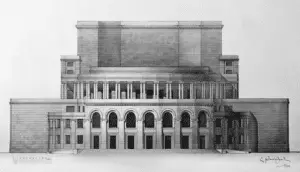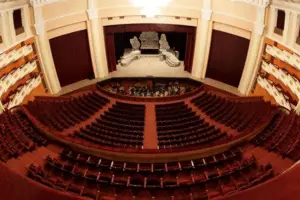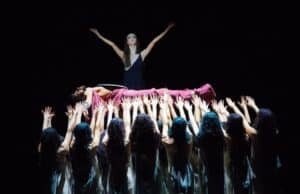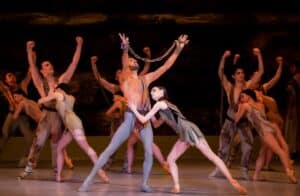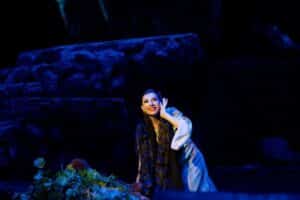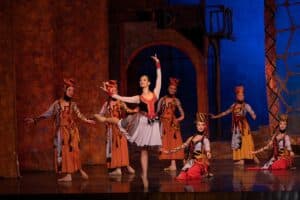In the heart of Armenia’s capital city Yerevan, stands the Armenian National Academic Theater of Opera and Ballet and the Aram Khachaturian Concert Hall, simply known as “The Opera” by locals. Built in the early twentieth century, this cultural hub showcases a blend of traditional Armenian architecture and contemporary design representative of its diverse repertoire. Today, works range from traditional Italian and Russian operas, to innovative twentieth century Armenian ballets. Whether you tour the theater or watch a performance, gaining a deeper understanding of the Armenian National Academic Theater of Opera and Ballet will not only broaden your knowledge of Soviet Armenian history but the country’s own rich cultural heritage as well.
History of the Armenian National Academic Theater of Opera and Ballet
By Abigail Crosby
In 1926 architect and Yerevan city planner Alexander Tamanian (1878-1936) was tasked with constructing the new opera house as part of a general reorganization and reconstruction of Yerevan. The architect planned the new layout of the city center around the opera house, placing it directly across from Republic Square (then known as Lenin Square) and surrounding it with a park that includes a manmade lake. The architect worked on the theater until his untimely death in 1936, when his son Gevorg Tamanian (1910-1993) took over.
While Alexander Tamanian’s designs originally only included the Opera and Ballet Theater, Gevorg Tamanian added the Aram Khachaturian Concert Hall, named for one of the most renowned Armenian composers of the 20th century, in the same style to house the Armenian National Philharmonic Orchestra. The orchestra was founded in 1925 by Arshak Adamian (1884-1956) and Alexander Spendiaryan (1871-1928). It performs both independently and as accompaniment to the theater’s ballet and opera.
The Armenian National Academic Theater of Opera and Ballet officially opened its doors on January 20, 1933 with Alexander Spendiaryan’s Armenian-language opera Almast (Ալմաստ, 1918). First premiering in 1930 at the Bolshoi Theater in Moscow, Spendiaryan’s opera follows the tale of the Armenian poem The Siege of Tmbouk Castle, and is now seen as the basis for modern Armenian national music, or music that uses folk motifs and strives to encapsulate the musical heritage and moral values of the nation within itself. The opera house today bears Spendiaryan’s name. The lasting impact of Almast was certainly not accidental – by the 1930s, each national republic in the Soviet Union was required to build a national opera house and produce a repertoire which reflected its national culture.
The theater’s first showcase of dance consisted of a loose collection of ethnographic dances performed by Russian and Armenian artists during an “evening of ballet” in 1933. The first full length ballets premiered in 1935: Swan Lake (Лебединое озеро, 1895) and La Fille Malgardée (1864). Two years prior, the National Ballet was founded by Russian choreographer, dancer, and musicologist Valentin Ivanovich Presnyakov (1877-1956). Having previously worked at the Odessa Music and Drama Institute in Ukraine, Presnyakov originally filled the company with artists from the Odessa Ballet Company. Presnyakov served as the director of the company until 1938, leaving the theater with a young yet established ballet company.
Despite beginning performances in 1933, the opera house was not fully completed until 1940 and minor construction work continued until 1953. The delays can be attributed in part to Alexander Tamanian’s death. A lack of sufficient funding also resulted in delays and ultimately a much less opulent final interior design than Tamanian had envisioned. However, in 1978 in honor of the architect’s 100th birthday, the theater underwent massive renovations – led by Gevorg Tamanian – to more closely match Tamanian’s sketches. Work continued until 1983 and included details such as renovating the dressing rooms with Armenian wood and marble, adding new chairs to the Concert Hall, and adding chandeliers, as well as updating the stage technology.
Most recently, a large monument in honor of Aram Khachaturian was erected outside of the Concert Hall in 1999 and more general repair work took place in 2002.
Today, Armenian dancer and choreographer Rudolph Kharatyan (1947-present) serves as the director of the National Ballet and continues to stage both national and international works.The Armenian National Philharmonic Orchestra (ANPO) also performs works by Armenian and international composers and regularly supports the performance of new orchestral works in order to engage with young audiences. Since 1989 ANPO has regularly toured Europe, North America, and Asia with notable performances at the Mariinsky Theater in 2016, the Berliner Konzerthaus in 2018, and a winter 2019-2020 tour through ten cities in China. The orchestra is currently led by Eduard Topchjan (1971-present) and hosts the International Yerevan Music Festival annually.
An Overview of Armenian National Opera, Ballet, and Orchestral Music
By Abigail Crosby
Whether you enjoy listening to classical music performed by a world class orchestra or watching internationally acclaimed singers and dancers perform in traditional and contemporary operas and ballets, or would like to explore what national music looks like in Armenia, the Armenian National Academic Theater can be the perfect place to explore your interests. Since its establishment in 1933, the opera house has fostered the creation and appreciation of national arts and culture in Armenia. This tradition holds strong today as new works are regularly added to the repertoire alongside old favorites like Aram Khachaturian’s Gayane (Գայանե, 1942) and Armen Tigranian’s Anoush (Անուշ, 1935). Check especially to see if Spartacus (Спартак, 1961) is playing, one of the most renowned Soviet ballets is also the work of Aram Khachaturian.
The opera house was built as part of a larger project to grow national arts in the Soviet Republics. However, the artists that pursued these goals not only studied their own history and culture for inspiration, but also collaborated with other regional theaters like Tbilisi’s Opera and Ballet Theater as well as major international theaters in Italy and Russia as they sought inspiration for how to effectively incorporate these elements.
Although Tigran Chukhajian (1937-1898), Arshak II is seen as the first Armenian opera, Spendiaryan’s Almast was the first to be staged in full in Armenia on the National Academic Theater’s opening night. Spendiaryan, a Russian-Armenian composer who trained with Nikolai Rimsky-Korsakov (1844-1908), drew inspiration for Almast from Nikoghayos Tigranyan’s (1856-1951) collections of Armenian folk music and the Armenian poem The Siege of Tmbouk Castle. Over the theater’s last ninety years, Spendiaryan’s masterpiece has been continuously reprised and has served as inspiration for many later works.
Tigranian’s Anoush, which first premiered on the Yerevan theater’s stage in 1935, is a four-act opera that tells the tragic love story of a young peasant girl named Anoush who falls in love with a shepherd who becomes her brother’s mortal enemy. It is based on the 1892 poem of the same name by Hovhannes Tumanyan. Tigranian’s opera was a huge success and thrilled local audiences with its distinct use of folk music and culture.
The first Armenian ballet, Gayane (Երջանկություն, 1939), was composed by Aram Khachaturian for the National Armenian Theater’s 10 Days of Armenian Art Tour in Moscow in the fall of 1939. Despite the general success of the tour, Khachaturian chose to rework the ballet with new choreography by Nina Anisimova (1909-1979) and a libretto by Konstantin Derzhanov (1903-1956). Gayane tells the story of a patriotic young Armenian woman’s struggle with her husband’s lazy, and at times treasonous, behavior.
Khachaturian’s success alongside the growing Yerevan State Choreographic School, led to a thriving ballet culture stemming from the walls of the Armenian National Academic Theater. In 1960, Adolphe Charles Adams’ (1803-1856) famed Giselle (1841) was first performed on the Yerevan stage, marking the start of its over fifty year run at the theater. From 1961-1967 Latvian choreographer Yevgeni Changa served as the director of the National Ballet, most notably staging the 1961 premier of Khachaturian’s Spartacus, which launched Armenian ballet into a “golden age” lasting until the late 1980s. By the end of the 1960s alone, six new national ballets, including Spartacus, had been staged in Yerevan: Emin Aristakesyan’s (1936-1998) Prometheus (1967), Edgar Hovhannisyan’s (1930-1998) Eternal Idol (1966) and Antouni (1969), Grigor Yeghiazaryan’s (1908-1988) The Lake of Dreams (Sevan Ballet, 1956), and Konstantin Oberlyan’s (1928-2014) Immortality (1969). During this period the theater staged seven full length operas and ballets annually and rehearsed a repertoire of nearly fifty works.
Unfortunately, by 1988 the ballet’s “golden age” came to a close as Armenia suffered a devastating earthquake followed by harsh economic consequences resulting from the Soviet Union’s collapse. Despite the theater’s dire loss of funding, audience members, and dancers during the 1990s, the twenty-first century has seen a new generation of highly skilled performers emerging from the Yerevan State Choreographic School. These artists, including the all-male touring troupe Forceful Feelings, founded in 2006 with the goal of promoting Armenian identity within ballet, have brought new life and creativity to Yerevan’s National Opera and Ballet Theater.
Visiting the Armenian National Academic Theater of Opera and Ballet Today
By Madeline Fyock
The Armenian National Opera and Ballet Theater, designed by the beloved Armenian architect Alexander Tamanyan, is a national gem. Located in the center of Yerevan, it is surrounded by delicious restaurants, noisy bars, and lively parks. There is always something going on in this part of the capital. Walking up to the theater, you will likely pass street musicians performing pop songs and traditional Armenian melodies, families attending local festivals, and children up and down the crowded avenue.
Performances at the National Theater are stunning and well worth the cost of a ticket, prices for which range from about 5,000 Dram (12.50 USD) to 25,000 Dram (62.48 USD). They can be purchased online at the Armenian National Theater website or in person at the door.
The National Theater performs a wide range of internationally and locally written operas and ballets. In the last few months of 2023, Tchaikovsky’s Swan Lake and The Nutcracker, Puccini’s Madame Butterfly, and Bizet’s Carmen are all running. As a vocal performance major, I was truly interested in seeing musical performances in Armenia. During my study abroad in Yerevan, I attended S. Prokofiev’s Romeo and Juliet and an orchestral concert of the music of the great Armenian composer Aram Khachaturian.
The Armenian National Opera’s production of Prokofiev’s Romeo and Juliet was breathtaking. In the balcony scene, the two star-crossed lovers twirled with each other under the moonlight. Their movements were powerful and graceful, and I remember being enchanted by the interactions between Romeo and Juliet. They moved as one – every strong and purposeful action from Romeo complimented the elegance and agility of Juliet’s movements. This classical ballet choreography recalled the dichotomy present in most traditional Caucasian dances.
Above: a 2023 video preview of The Armenian National Opera’s production of Prokofiev’s Romeo and Juliet.
Every aspect of this pas de deux was gentle and intimate, from the orchestral music to the way in which the lovers intertwined as they danced. This was all enhanced by the light and
delicate fabric of Juliet’s dress, which flowed and complemented her every move. For the first time, I appreciated the importance of beautiful fabric and scenery; every attribute of this ballet added to its quiet beauty and strong gracefulness. Romeo and Juliet was truly the most emotional, intentional, and enchanting ballet I have ever seen.
I also attended an orchestral concert of Aram Khachaturian’s beautiful music, which is grand and epic. In my experience as a vocal performance major, such pieces are challenging to play well because it is easy to do so without nuance, as you simply get caught up in the loud notes. However, the Aram Khachaturian Concert Hall orchestra played his music very intentionally, which was evident in their use of piano (a musical term used to describe playing an instrument at a quiet volume). As a musician who has participated in various ensembles for years, I understand how hard it is for a large ensemble to play piano well. It is easy for musicians to create a full, loud sound, but it is more challenging for them to support quieter lines. Both loud and soft dynamics are necessary, however, because these add dimension and depth to a piece of music. Music is meant to tell a story, so it must include sections that are quieter and more peaceful and others that are loud, bold, and epic. Stories contain conflict, journeys, and adventures, and so the music must reflect that in its dynamics. Throughout the Aram Khachaturian concert, I noticed that the orchestra produced a beautifully supported piano. Each piece was not purely big and epic. The dichotomy between the orchestra’s large, epic lines and their quiet, yet full sound showed the orchestra’s intentionality and precision in the music.
One of the most surprising parts of attending this performance was the applause. The audience applauded together, every clap occurring simultaneously with the rest. This was disconcerting at first, but I grew accustomed to it after a few rounds. At the Armenian National
Theater, I also noticed that the audience reserved a standing ovation for the highest honor. Even if a performance is considered great, the audience does not stand to applaud. It is customary to only stand for the best performance. This is contrary to performances in the United States, and so it is important to note.
These performances at the Armenian National Opera and Ballet Theater were incredible in their intentionality and beauty. There are many stunning and culturally-rich aspects to Armenia, but attending the National Opera is truly one of the most enriching experiences that will give anyone insight into the power of good art and the beauty of the Armenian culture.
Tours of the Theater
By Abigail Crosby
No matter what type of performance you choose to enjoy, watching the Armenian National Opera, Ballet, or Philharmonic Orchestra at Yerevan’s breathtaking opera house will immerse you in a rich, nuanced cultural experience. If you don’t have time to see a performance, look into a tour of the opera house! Explore the theater’s architectural triumphs and hidden gems like the backstage, winding halls, and balconies overlooking the city as you meet artists and theater professionals. Whichever you choose to do, a visit to the Armenian National Academic Theater of Opera and Ballet will broaden your knowledge of the nation’s culture and enrich your experience in Armenia.
You’ll Also Love
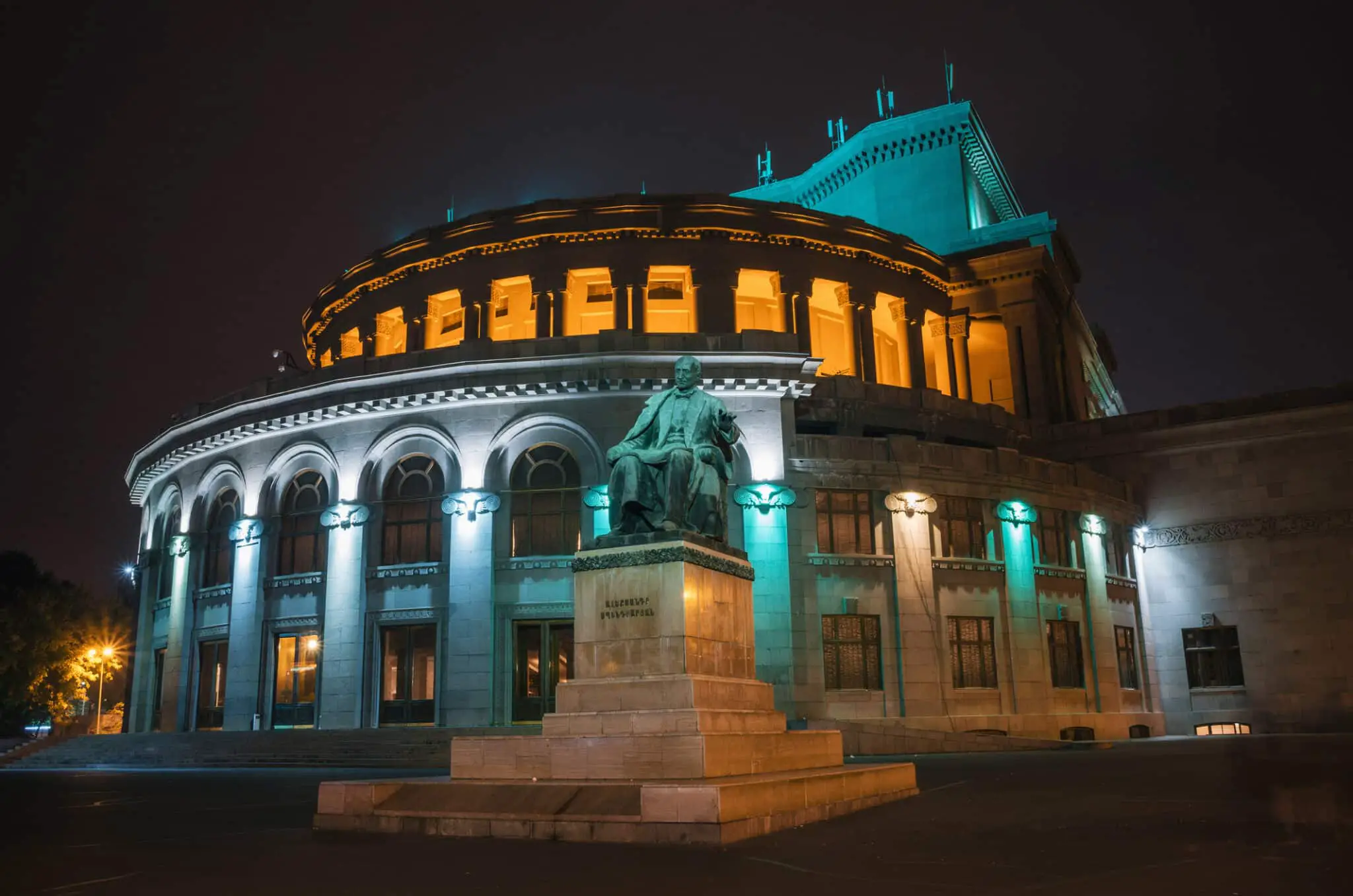
The Armenian National Academic Theater of Opera and Ballet
In the heart of Armenia’s capital city Yerevan, stands the Armenian National Academic Theater of Opera and Ballet and the Aram Khachaturian Concert Hall, simply known as “The Opera” by locals. Built in the early twentieth century, this cultural hub showcases a blend of traditional Armenian architecture and contemporary design representative of its diverse repertoire. […]
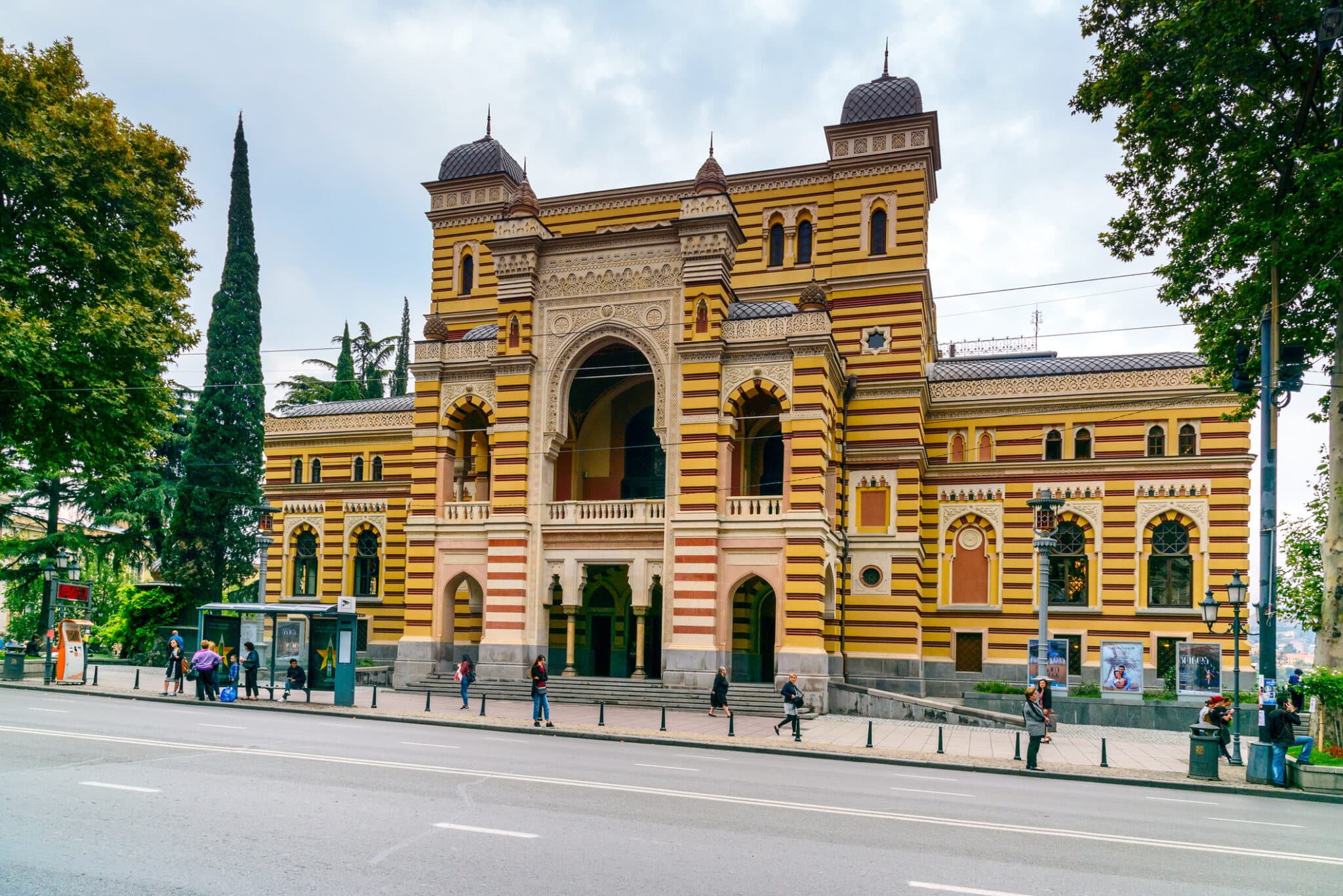
The Opera and Ballet Theater of Tbilisi
The Opera and Ballet Theater of Tbilisi has a rich history and offers a diverse range of opera and ballet performances – from traditional masterpieces to innovative contemporary offerings. Built in the late 19th century, the theater showcases a stunning blend of neoclassical and Moorish architectural styles as well as opulent interiors, creating a majestic […]

The Mariinsky Theater: St. Petersburg’s Operatic and Ballet Traditions
The Mariinsky Theater, located in St. Petersburg, Russia, is one of the most iconic and prestigious cultural institutions in the world. Since 1783, it has showcased some of the most famous ballets, operas, and orchestral performances of all time on both its stage and traveling to perform in theaters across the globe upon invitation. In […]

Kyrgyz State Opera and Ballet Theater in Bishkek: History and Artistry Through Student Eyes
The Kyrgyz State Opera and Ballet Theater is a prominant fixture in central Bishkek with a nearly century-old history. It is a pride of the city’s artistic and intellectual community and often recommended to SRAS students studying in Bishkek by locals. Below is the history and performances of this great institution as told by American […]
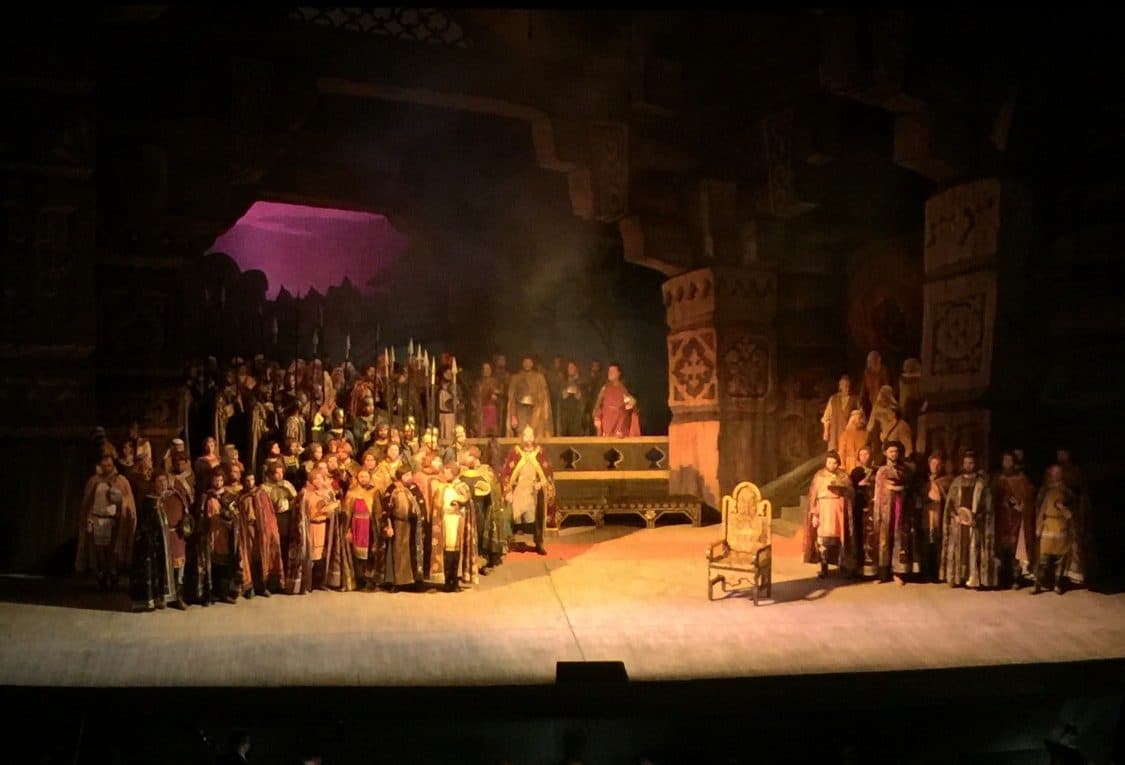
A Musicologist Recommends Three Russian Operas for You to Watch at the Mariinsky
I was so excited about studying abroad in St. Petersburg because I got the chance to see a lot of Russian operas that are not performed in theaters in the West. As a Russian musicologist, it was wonderful to have excess to the musical performances at the Mariinsky Theaters. Opera is one of the most […]


